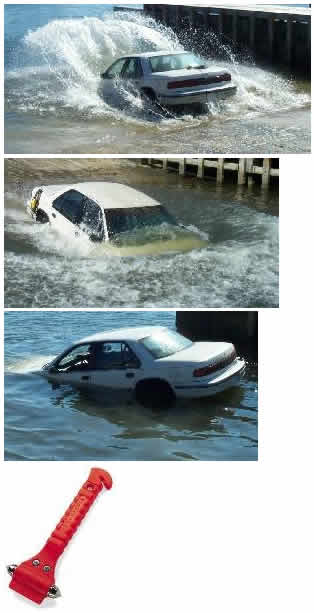Each year, there are approximately 1,500 incidents and 600 deaths occur involving vehicles that have gone off the road and plummeted into the water. Therefore, the public needs to plan for these types of emergencies by (A) rehearsing the steps necessary for a successful self-rescue from a vehicle in the water, and (B) having the rescue/escape tools readily available for use during this type of emergency situation. In addition, First Responder agencies need to provide the training necessary to prepare their personnel to respond to these types of incidents, and should provide the Personal Protective Equipment and rescue tools necessary for a safe and effective response to vehicles in the water.

SAFETY
Public service campaigns should be increased in an effort to educate the public about the risks of driving through flooded highways; driving in close proximity to bodies of water during snow, rain or other slippery conditions; or driving over lakes, rivers or ponds that have frozen over. The following information should be included in these efforts:
It only takes 6" to 2' of water to float a vehicle off its wheels. Heed warnings about low water crossings and do not attempt to cross flooded highways.
8" to 12" of new, clear, hard ice is required to drive a small vehicle onto the ice. 12" to 15" of new, clear, hard ice is required to drive a medium-sized truck onto the ice.
Wearing seat belts will increase your chances of surviving a crash into the water.
If a vehicle leaves the road and lands in deep water, the vehicle's float time at the surface of the water may be as little as 30 seconds, or as much as 4 minutes. Factors which effect the float time include closed, sealed, and intact windows and weather seals. Because of the location of the motor in the front of the vehicle, the vehicle will immediately assume an angled nose down position in the water.
ESCAPE
Because of the relatively limited time frame for self-rescue, the decision to escape the vehicle must be made immediately. However, because of the angled nose-down position in the water and the pressure exerted by the water against the doors, as well as structural damage to the vehicle as a result the crash, it may be extremely difficult or impossible to open the driver's side and passenger doors of the vehicle in order to effect an escape. Therefore, the only avenue of escape may be through the car door windows.
Studies have shown that the electric power may stay on for as much as 10 minutes. Or, the battery can short out immediately, making the electric window switches useless. Therefore, in order to escape through the car door windows, the occupants must be able to punch out the windows. Because the door windows, as well as the rear window, are constructed of tempered glass, they will easily shatter using an appropriate rescue/escape tool, such as a life hammer device, or a spring-loaded window punch. Many of the commercially available rescue/escape tools also have an integrated seat-belt cutter/blade that provides the ability to slice away a seat belt should its release mechanism fail or jam.
The decision to escape the vehicle must be made as soon as the vehicle leaves the road and enters the water. If the occupants delay their escape from the vehicle and the vehicle begins to sink, it may not be possible to effect an escape until the water pressure has equalized inside the vehicle. Also, should the vehicle land in deep water, if the water depth is less than 14', the vehicle will usually come to rest on the bottom on all four wheels, assuming there are no large rocks or other debris on the bottom. However, water depths greater than 14' usually results in the vehicle turning turtle and landing on its roof. Needless to say, being upside down in a dark environment with water rushing in will totally disorient the occupants of the vehicle.
We advocate the escape principles of either SOS-GO or PO-GO:
SOS-GO
- S = Stay Calm; Assess the Situation, Slow your Breathing
- O = Open your Window(s) or Door(s)
- S = Disengage your Seatbelt
- GO = Get Out!
PO-GO
- P = Punch (open) your Seatbelt Release
- O = Open your window or door
- GO = Get Out!
In order to accomplish this, these emergency procedures should be rehearsed before the emergency occurs. Use a body reference point to identify and locate the door latch, window crank or electric window switch. As an example, the driver should practice finding the location of these by touching his knee or hip with his/her left hand and then move the hand laterally to the door. A rescue/escape tool should be immediately available for punching out the window and cutting seatbelts. This tool should be mounted on the sidewall of the driver's side compartment, attached to the key ring, or located in some other conspicuous location that can be easily accessed during an emergency. Consideration should be given to additional tools for the passenger side and rear seat compartments as well.
If there are multiple occupants, once an escape route has been opened, each occupant should hold hands in a human chain and escape from the same route. If young children are secured in car seats, based on a limited study, we found that of those car seats we evaluated, they were sufficiently buoyant to float a child on the surface of the water. Therefore, the car seat can be cut loose from the seat belt and removed from the vehicle with the child still secured in the car seat.
There is no doubt that when a vehicle leaves the roadway and plunges into the water, this would be an extremely frightening experience, especially during the winter months with cold water posing additional risks and hazards to the occupants. But, by rehearsing the emergency escape and survival procedures and having the rescue/escape tools readily available, occupants can safely and rapidly self-extricate themselves from this situation before the vehicle begins to sink.
RESCUE
Public Safety and Rescue personnel should be appropriately trained, protected, and equipped to effectively and safely respond to vehicles in the water. Besides the availability of Personal Flotation Devices (PFDs), Wetsuits, and/or Dry-Suits, rescue personnel should have the tools readily available to punch in the car door windows or the rear window in order to rapidly extricate a victim or multiple victims from a vehicle in the water. Spring-loaded window punches or life hammer type devices with seat-belt cutters provide the rescuer with the opportunity to gain immediate access to the victims and to cut away the victim's seat belt for their immediate extrication from the vehicle.
As standard protocol, whenever a rescue agency is dispatched to respond to a vehicle in the water, the dispatch of a wrecker should be automatic in every community and emergency response system. Upon arrival of the wrecker, it can be used to assist in the stabilization of the vehicle during and after the rescue of the vehicle occupants.
RESCUE/ESCAPE TOOLS
We evaluated a number of rescue/escape tools. These tools are either hammer-type devices or spring-loaded window punch devices. Although both types of tools were effective in breaking door windows and rear car windows, we found that the hammer-type devices were more dependable. Each of the spring-loaded window punch devices we tested were effective in breaking the windows when they were first removed from their packaging. However, after several practice drills, the points on these devices became dull which resulted in their failure to work and break the windows. Therefore, we caution against using the spring-loaded window punches for any purpose other than for breaking the windows. Furthermore, using a spring-loaded window punch, without appropriate hand protection, increased the chance of suffering cuts on the hand than the use of the hammer-type device. Regardless, rescue personnel should always wear an appropriate water rescue, neoprene, or fire glove when using any type of device to shatter door windows or vehicle rear windows.
DISPATCHER PROTOCOLS
All emergency dispatchers should be trained in this subject and should be prepared to give self-rescue instructions to the callers prior to the arrival of Fire and Rescue personnel.










